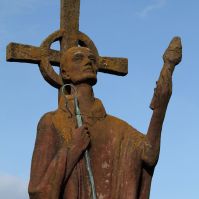 The Catholic Education Resource Center defines lust as "the inordinate desire for sexual pleasure." Typically, lust is associated with sexual sins, but it would be fair to describe lust as “desire.” There is a distinct difference between a need and a desire, and lust could be classified as an inappropriate desire. One could be lusting for food rather than simply needing food for sustenance. Most religions would categorize the desire between a husband and wife as passion, but the desire between a married man and a woman who was not his wife as lust.
The Catholic Education Resource Center defines lust as "the inordinate desire for sexual pleasure." Typically, lust is associated with sexual sins, but it would be fair to describe lust as “desire.” There is a distinct difference between a need and a desire, and lust could be classified as an inappropriate desire. One could be lusting for food rather than simply needing food for sustenance. Most religions would categorize the desire between a husband and wife as passion, but the desire between a married man and a woman who was not his wife as lust.
Lust became associated with sexual desire most likely because of this verse:
“You have heard that it was said, ‘You shall not commit adultery.’ But I tell you that anyone who looks at a woman lustfully has already committed adultery with her in his heart” (Matthew 5:27–28, NIV).
The Greek word that translates as lust in that scripture is also translated as desire in other verses that have nothing to do with lust. For our purposes, lust will focus on self-seeking sexual desire. Just keep in mind that lust encompasses much more.
Traditional Thoughts on Lust
If there was a pecking order of the seven deadly sins, lust would be on the bottom. It is seen as the least serious. It could be said that lust is least harmful to the person and to the community than the other capital sins. Interestingly, it’s also probably the most popular sin in art and literature.
Lust has also been translated as extravagance. The Latin word is luxuria, which is represented in artwork as a woman with naked breasts being bitten by snakes. In Ecclesiastes, Solomon compares a woman’s passion to a snare. Solomon is warning against lust and its evils, just as the early Romans and Greeks did.
Dante’s “Divine Comedy” is one of the most notable pieces of literature about the seven deadly sins. The lustful are in a whirlwind, never getting any rest. The whirlwind represents a lack of self-control. To purge themselves, the guilty must walk through flames.
The saints of the Middle Ages had strange ways of dealing with lust. It’s said that St. Francis of Assisi rolled in the snow to remain pure. One legend says that he threw himself into a rose bush to avoid a woman. Other saints dove into icy ponds to cure themselves of their desires. Knowing how hard some men worked to avoid lust can help us understand how society’s attitudes about sexuality came about.
In the 1800s, Arthur Schopenhauer, a German philosopher, considered lust as a prelude to misery. This could be due to eastern religions that view lust as a type of craving and coveting. Buddhist tradition says that suffering is inherent and that the reason men suffer is due to lust. The Buddhist religion says that the only natural way to eliminate suffering is the Noble Eightfold Path. Christians aren’t the only ones who view lust as wrong.
The View of Lust Today
Lust, which encompasses fornication, masturbation and adultery, is considered a sin today, even though many of the seven deadly sins are not regarded as capital sins today. In the Christian tradition, punishment for lust is to be smothered by fire and brimstone. However, Christians can be forgiven of lust.
Plato didn’t shun lust but considered it part of love and learning. Lust is learning to love a beautiful body, then learning to appreciate beauty in other bodies, and finally, in the soul. Lust can be cured by transcending the natural urges and learning that there is more to life than extravagance and desire. It’s the first step on a ladder of love, which changes the dynamics of lust, making it part of one’s development rather than something to be avoided.



